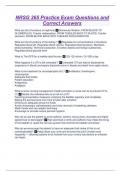NRSG 265 Practice Exam Questions and
Correct Answers
What are the 3 functions of nephrons ✅Glomerular filtration: FROM BLOOD TO
GLOMERULUS, Tubular reabsorption: FROM TUBULES BACK TO BLOOD, Tubular
secretion: FROM BLOOD BACK INTO TUBULES FOR EXCRETION
What are the 8 functions of the kidney ? ✅Regulates ion concentrations in the blood,
Regulates blood pH, Regulates blood volume, Regulates blood pressure, Maintains
blood osmolarity, Hormone production, Excretes wastes and foreign substances,
Regulates blood glucose level
What is The GFR for a healthy adult human ✅120-125 ml/min. Or 180l a day
What happens if a UTI is left untreated ? ✅Untreated UTI can lead to bacteraemia
(organisms in blood) and sepsis (bacterial toxins in blood) and death from septic shock.
What is the treatment for uncomplicated uti's ? ✅Antibiotics: trimethoprim,
nitrofurantoin
Adequate fluid intake
Patient education
Antipyretics
Analgesia
What is some nursing management/ health promotion a nurse can do to prevent UTI's.
(7) ✅Identify the individual who is at risk for a UTI
Teaching preventative measures: emptying the bladder regularly and completely
Wiping the perineal area from front to back after urination;
Drinking an adequate amount of fluids
Avoid unnecessary catheterisation and early removal of indwelling catheters
Wash hands and use aseptic technique
Encourage or provide routine perineal hygiene
Why do we ask the patient to avoid caffeine, alcohol, citrus juices, chocolate and highly
spiced food or beverages? ✅High acid food or drink and caffeine may irritate the lining
of the bladder or upset the nervous system that controls the bladder and bowel
Why do we encourage the patient to have an adequate fluid intake (if this is not
contraindicated)? ✅Helps dilute your urine and ensures that you'll urinate more
frequently — allowing bacteria to be flushed from your urinary tract before an infection
can begin.
,What is the nursing management of an AKI ✅Monitor vital signs (TPR, BP, SpO2,
LOC)
Strictly monitor and record fluid intake and output
Examine urine for colour, specific gravity, glucose, protein, blood and sediment daily.
Assess the patient's general appearance, including skin colour, oedema, neck vein
distension, bruising, signs of dehydration, e.g., thirst, dry mucus membranes, poor skin
turgor, concentrated urine.
Check all cannulas for inflammation i.e., redness, heat, pain and swelling.
Evaluate the patient's mental status and level of consciousness.
Examine the oral mucosa for dryness.
Auscultate the lungs for crackles and rhonchi or diminished breath sounds.
Assess ECG or cardiac monitor for arrhythmias.
Review laboratory values and diagnostic test results.
What is Chronic kidney diease ✅Chronic Kidney Disease (CKD) involves progressive
and irreversible loss of kidney function. Progressive loss of renal function causes
reduced sodium filtration and inappropriate suppression of tubular reabsorption that
ultimately lead to volume expansion and hypervolaemia.
What are the most important nutrition goals for patients with chronic kidney disease
(CKD) ? ✅Reduce protein, potassium and sodium intake
A 27-year-old male has a severe kidney obstruction leading to removal of the affected
kidney. Which of the following would the nurse expect to occur in the weeks following
removal of the affected kidney? ✅Compensatory function of the remaining kidney
What is Multiple Organ Dysfunction Syndrome (MODS)? ✅Is the development of
potentially reversible damage of two or more organ systems due to the effects of
systemic cytokines released following sepsis
What is Acute Respiratory Distress Syndrome (ARDS) ✅A sudden and progressive
form of acute respiratory failure due to vasodilation of the alveolar capillaries, from
released cytokines due to sepsis, resulting in fluid in the blood moving into alveoli and
preventing gas exchange.
What is Disseminated Intravascular Coagulation (DIC)? ✅Is a condition in which small
blood clots develop in the circulation, blocking small blood vessels. The increased
clotting uses up the platelets and clotting factors needed to control bleeding, causing
excessive bleeding and interruption of blood flow to organs and tissues.
What are some treatments for sepsis ? ✅Assess for airway patency and administer
oxygen
Obtain IV access, blood cultures (before administration of antibiotics) and baseline
blood tests, including lactate
Obtain other samples if they will not delay antibiotic treatment (e.g. sputum, urine, pus)
, Administer antibiotics (should be administered in first hour)
IV fluid bolus if patient showing signs of shock/hypoperfusion - 250-500 mL crystalloid,
transfer to ICU if transient or no response to treatment
Examination for source of sepsis,
Monitor fluid balance and urine output,
Provide cardiovascular support with medications such as vasopressors if required
Additional therapies such as glucocorticoids, inotropic or other drugs can also be used.
List 4 nursing diagnoses and priority Care problems ✅Risk of impaired gas exchange
related to altered oxygenation and effect of bacteria toxins on the breathing centre in the
brain
Goal: to maintain adequate tissue perfusion
Risk of hypovolaemia related to the fluid shift from intravascular to extracellular space
Goal: to maintain circulatory volume
Risk for a septic shock related to untreated infection secondary to vasodilation and
hypotension
Goal: to identify and treat sepsis before shock develops
Hyperthermia related to sepsis secondary to severe infection as evidenced by a raised
body temperature (e.g., Temp 38.5 oC), rapid and shallow breathing, flushed skin,
profuse sweating and increased pulse.
Goal: to stabilise the body temperature within the normal range
What are some of the experiences of Post sepsis syndrome? ✅Sleep disturbances
including insomnia
Nightmares, hallucinations, flashbacks and panic attacks
Muscle and joint pains which can be severe and disabling
Extreme tiredness and fatigue
Inability to concentrate
Impaired mental (cognitive) functioning
Loss of confidence and self-belief
What are sepsis preventions? ✅Vaccinations, completing full course of antibiotics,
maintain good hygiene, clean open wounds,
In patients with severe sepsis:
Select one:
a.




